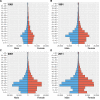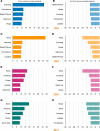The role of migration networks in the development of Botswana's generalized HIV epidemic
- PMID: 37665629
- PMCID: PMC10476964
- DOI: 10.7554/eLife.85435
The role of migration networks in the development of Botswana's generalized HIV epidemic
Abstract
The majority of people with HIV live in sub-Saharan Africa, where epidemics are generalized. For these epidemics to develop, populations need to be mobile. However, the role of population-level mobility in the development of generalized HIV epidemics has not been studied. Here we do so by studying historical migration data from Botswana, which has one of the most severe generalized HIV epidemics worldwide; HIV prevalence was 21% in 2021. The country reported its first AIDS case in 1985 when it began to rapidly urbanize. We hypothesize that, during the development of Botswana's epidemic, the population was extremely mobile and the country was highly connected by substantial migratory flows. We test this mobility hypothesis by conducting a network analysis using a historical time series (1981-2011) of micro-census data from Botswana. Our results support our hypothesis. We found complex migration networks with very high rates of rural-to-urban, and urban-to-rural, migration: 10% of the population moved annually. Mining towns (where AIDS cases were first reported, and risk behavior was high) were important in-flow and out-flow migration hubs, suggesting that they functioned as 'core groups' for HIV transmission and dissemination. Migration networks could have dispersed HIV throughout Botswana and generated the current hyperendemic epidemic.
Keywords: HIV/AIDS; epidemiology; global health; human; migration; mobility patterns; network science.
Plain language summary
Over 25 million people in sub-Saharan Africa live with HIV. After reporting its first AIDS case in 1985, Botswana is one of the most severely affected countries in the region, with one in five adults now living with HIV. Movement of the population is likely to have contributed to a geographically dispersed, and high-prevalence, HIV epidemic in Botswana. Since 1985, urbanization, rapid economic and population growth, and migration have transformed Botswana. Yet, few studies have analyzed the role of population-level movement patterns in the spread of HIV during this time. By studying micro-census data from Botswana between 1981 and 2011, Song et al. found that the country’s population was highly mobile during this period. Reconstructions of internal migration patterns show very high rates of rural-to-urban and urban-to-rural migration, with 10% of Botswana’s population moving each year. The first reported AIDS cases in Botswana occurred in mining towns and cities where high-risk behavior was prevalent. These areas were also migration hubs during this period and could have contributed to the rapid spread of HIV throughout the country as infected individuals moved back to rural districts. Understanding human migration patterns and how they affect the spread of infectious diseases using current data could help public health authorities in Botswana and additional sub-Saharan African countries design control strategies for HIV and other important infections that occur in the region.
© 2023, Song et al.
Conflict of interest statement
JS, JO, JP, LB, KS, EV, SB No competing interests declared
Figures










Update of
-
Population mobility and the development of Botswana's generalized HIV epidemic: a network analysis.medRxiv [Preprint]. 2023 Feb 2:2023.02.01.23285339. doi: 10.1101/2023.02.01.23285339. medRxiv. 2023. Update in: Elife. 2023 Sep 04;12:e85435. doi: 10.7554/eLife.85435. PMID: 36778345 Free PMC article. Updated. Preprint.
References
-
- African Natural Resources Center Debswana Diamond Company and the Government of Botswana: an HIV/AIDS public-private partnership programme. 2016. [October 17, 2022]. https://www.afdb.org/fileadmin/uploads/afdb/Documents/Publications/anrc/...
-
- Barnett T, Fantan T, Mbakile B, Whiteside A. The Private Sector Responds to the Epidemic: Debswana–a Global Benchmark. Geneva, Switzerland: UNAIDS; 2002.
-
- Bell M, Blake M, Boyle P, Duke-Williams O, Rees P, Stillwell J, Hugo G. Cross-national comparison of internal migration: Issues and measures. Journal of the Royal Statistical Society. 2002;165:435–464. doi: 10.1111/1467-985X.t01-1-00247. - DOI

